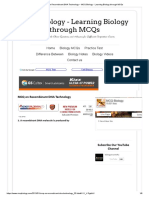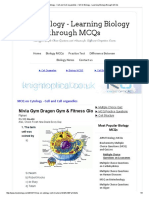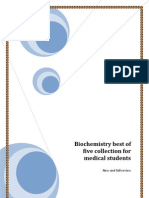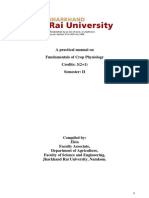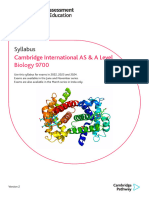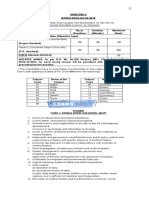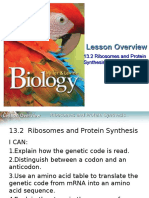Genetics
Genetics
Uploaded by
Naji Mohamed AlfatihCopyright:
Available Formats
Genetics
Genetics
Uploaded by
Naji Mohamed AlfatihOriginal Description:
Copyright
Available Formats
Share this document
Did you find this document useful?
Is this content inappropriate?
Copyright:
Available Formats
Genetics
Genetics
Uploaded by
Naji Mohamed AlfatihCopyright:
Available Formats
1.
The cDNA library differs from a genomic DNA library in: a) Excluding DNA that encodes mitochondrial proteins b) Excluding DNA that encodes ribosomal proteins c) Only by having introns excluded from genes d) Having longer polynucleotide fragments e) Reflecting the whole activities of all tissues in multicellular organisms 2. The genetic code is: a) Ambigeous b) Overlapping c) Degenerate d) None specific e) None of the above 3. In contrast to DNA polymerase, RNA polymerase: a) Fills the gap between Okazaki fragments b) Works only in the 5'to 3'direction c) Edits as it synthesizes d) Synthesize RNA primer to initiate DNA synthesis e) Adds nucleoside monophosphates to the growing polynucleotides 4. A promoter site on DNA: a) Transcribes repressor b) Initiates transcription c) Codes for RNA polymerase d) Regulates termination e) Translates specific proteins 5. The portion of DNA which is transcribed but not translated is called: a) Insert b) Intron c) Vector d) Exon e) Ribozyme 6. Which of the following sequences is complementary to TGGCAGCCT: a) TCCGACGGT b) ACCGTCGGA c) ACCGUCGGA d) AGGCTGCCA e) TGGCTCGGA 7. tRNA reacts specifically with: a) Specific aminoacyl-adenylates b) ATP c) Free amino acids d) The golgi apparatus e) Nuclear DNA
8. The polymerase chain reaction (PCR) requires: a) A double stranded DNA at least partially of known sequence b) A synthetic non-complementary RNA c) Dideoxynucleotide triphosphates d) Reverse transcriptase e) A pair of specific mismatched DNA primer 9. A cDNA library differs from a genomic DNA library: a) In excluding DNA that encodes mitochondrial proteins b) In excluding DNA that encodes ribosomal proteins c) Only by having introns excised from gene d) In having longer polynucleotide fragments e) In reflecting only the activities of the tissue from which it is derived 11. Restriction endonucleases: a) Digest DNA duplex molecules from the 5'ends b) Attack only single stranded DNA c) Have base sequence specifity d) Randomly digest double stranded DNA molecules e) Are not produced in prokaryotes 12. All of the following statements concerning replication of DNA in prokaryotes are true except: a) Synthesis of new strands occurs in a 5'to 3' direction b) Temple strand is read in a 3' to 5' direction c) Lagging strand synthesis is discontinuous d) Synthesis occurs in both strands e) It is a conservative process 13. Restriction endonucleases type II: a) Are DNA dependent polymerases b) Are obtained from viruses c) Cut double-stranded DNA from any source d) Catalyze labeling of the source e) All of the above is correct 14. To constract cDNA library: a) Reverse transcriptase is needed b) mRNA is the starting material c) Synthetic linkers with restriction sites are needed d) Restriction enzymes are used to cut the vector based on the linker choice e) All of the above is correct 15. The sigma subunit of prokaryotic RNA polymerase: a) Is required to hold the subunits of the core enzyme together b) Remains with the RNA polymerase until the termination of transcription c) Is required for proper recognition of prometer d) Contains the active site for RNA synthesis e) Is required for termination of transcription
16. An anticodon is: a) The part of DNA molecule that codes termination b) A 3-nucleotide sequence of messenger RNA molecule c) A specific nucleotide sequence of a tRNA molecule d) A nucleotide triplet of a ribosomal RNA molecule e) Covalently bound to colon 17. The polymerase chain reaction (PCR) requires: a) A double stranded DNA of totally unknown sequence b) A pair of synthetic RNA primers c) Dideoxynucleotide triphosphates d) Reverse transcriptase e) Both B and D are correct 18. In lagging DNA strand: a) There are several RNA primers b) DNA synthesis is discontinuous c) Polymerization proceeds in 5'3' direction d) DNA polymerase III is needed e) All of the above is correct 19. Which of the following statements about DNA ligase is correct? a) DNA ligase seals the gaps between RNA primers and Okazaki fragments b) DNA ligase makes single stranded nicks which relieve the supercoiling c) The energy source for DNA ligase can be either NADPH or GTP depending on the species d) DNA ligase joins the free 3' hydroxyl on the Okazaki fragment to the 5' carbon on the growing strand e) It is classified as endonuclease enzyme 20. DNA synthesis and RNA synthesis differ in: a) Production of a complementary polynucleotide from a template b) Release of pyrophosphate as a reaction product c) Synthesis proceeds in the 5' to 3' direction d) Proofreading to eliminate errors e) First nucleotides incorporated are RNA 21. Restriction sites of restriction endonucleases: a) Are on double stranded DNA b) Can be 4-7 bp long c) Provide blunt and sticky ends d) Are less when the enzyme recognizes longer DNA sequences e) All of the above is correct 22. The Polymerase Chain Reaction a) Requires specific primers to amplify a DNA sequence b) Involves cyclic thermal denaturation and reannealing of DNA c) Helps diagnosing sub-clinical infections d) Exploits Taq polymerase for DNA replication e) All of the above is correct
23. Which of the following is TRUE for cDNA? a) DNA, a primer, ATP, dideoxynucleotides, DNA polymerase b) DNA, end labeled primer, dNTP's, dideoxynucleotides, DNA polymersae c) RNA, two primers, NTP's, dideoxynucleotides, RNA polymerase II d) RNA, two primers, NTP's, AZT, Taq polymerase e) DNA, a primer, dNDP's, dideoxyribonucleotides, RNA polymerase II 24. The following is employed in DNA sequencing: a) Plasmids b) Bacteriophage lambda c) Dideoxynucleotide triphosphate d) Reverse transcriptase e) Ligases 25. Initiation of protein biosynthesis: a) Involves elongation factor 2 b) Starts by association of the two ribosomal units c) Requires binding of the ternary complex to 40S subunit d) Does not involve association of the two ribosomal subunits e) Requires CTP 26. Amino-acyl-tRNA synthetase: a) Recognizes codons on mRNA b) Recognizes the anti-codon on the tRNA c) Catalyses the binding of amino acid to its respective tRNA d) Recognizes the D arm of the specific tRNA e) Both C and D are correct 27. All of the following statements concerning replication of DNA in prokaryotes are true except: a) Synthesis of new strands occurs in a 5' to 3' direction b) Template strand is read in a 3' to 5' direction c) Lagging strand synthesis is discontinuous d) Synthesis occurs in both strands e) It is a conservative process 28. Which of the following is needed for a polymerase chain reaction? a) A thermostable DNA polymerase b) Helicase c) Primase d) One of the target DNA strands e) Reverse transcriptase
29. The following is true about DNA-dependent RNA polymerase: a) Pol I is responsible for synthesis of rRNA and it is less sensitive to alphaamanitin b) Pol II is responsible for synthesis of mRNA c) Pol III is responsible for synthesis of tRNA d) RNA Polymerases have unwindase activity e) All of the above is correct 30. In eukaryotes, hnRNA's undergo elaborate post-transcriptional processing as follows: a) tRNA is charges with its respective amino acids b) mRNA is capped at the 5' end c) rRNA is polyadenylated at the 3' end d) Intron sequences are spliced by snRNA's e) Exons are removed and intros are ligated 31. Reverse transcriptase exhibits the following functions: a ) RNA directed DNA synthesis b) DNA dependent RNA synthesis c) DNA dependent DNA synthesis d) Proofreading of cDNA e) None of the above is correct 32. With regard to the lac operon, an inducer substance binds to: a) The operator, causing an allosteric shift which initiates transcription b) A repressor protein, which then dissociates from the operator c) Lactose which binds the DNA and completes transcription of the structural genes d) A repressor protein, causing it to bind tightly to the operator e) The promoter, which initiates transcription 33. Transcriptional Activator Proteins: a) Transcribe a messenger off a DNA template b) Bind to ribosomes to activate the production of specific proteins c) Are produced during an infection of bacteria by a phage d) Are essential to function of transfer RNA's during translation e) Bind regions near a eukaryotic gene and allows an RNA polymerase to transcribe a gene
34. The Wobble Hypothesis says: a) There is loose pairing between the 5' end of a single codon and the 3' end of more than one anticodon b) There is loose pairing between the 5' end of a single anticodon and the 3' end of more than one codon c) There is a loose pairing between the 3' end of a single anticodin and the 5' end of more than one codon d) There is loose pairing between the 3' end of a single codon and the 5' end of more than one anticodon e) Codons of a single amino acid differ mainly in the 3rd position, rarely in the 2nd position but never in the 1st position 35. Which of the following sets of components are required for enzymatic DNA sequencing? a) DNA, a primer, ATP dideoxynucleotides, DNA polymerase b) DNA, end-labelled primer, dNTP's, dideoxynucleotides, DNA polymerase c) RNA, two primers, NTP's, dideoxynucleotides, RNA polymerase II d) RNA, two primers, NTP's, AZT, Taq Polymerase e) DNA, a primer, dNDP's, dideoxyribonucleotides, RNA polymerase II 36. A mutation in structural gene that changes the UGA termination codon to UGG codon (trp). What effect would this mutation most likely cause? a) The RNA will not be translated b) The RNA transcribed from the gene will be much longer than normal c) The polypeptide produced will be shorter than expected d) The polypeptide produced will have extra amino acids e) No effect at all 37. What is the maximum number of amino acids in a peptide coded by the polyribonucleotide 5' CCAUGUUUGGGUGAGGGCC3' in an in-vivo system starting from the first base? a) Six b) Two c) Three d) Four e) Five 38. All of the following statements about ribosomes are correct except: a) All ribosomes have two subunits b) Eukaryotic cells have 80S ribosomes and protein synthesis on these ribosomes can be inhibited by cycloheximide c) Prokaryotic cells have 70S ribosomes and protein synthesis on these ribosomes can be inhibited by chloramphenicol d) Mitochondria have 80S ribosomes and protein synthesis on these ribosomes can be inhibited by cycloheximide e) The larger subunits of all ribosomes have the enzyme peptidyl transferase which forms peptide bonds
39. Which of the following is mimicked by the antibiotic puromycin? a) Peptidyl-tRNA b) Aminoacyl-tRNA c) Peptidyl transferase d) Translation release factors e) Formylmethionyl-tRNA 40. Deamination of cytosine in mRNA produces: a) An insertion mutation b) A deletion mutation c) A point mutation d) A purine e) Thymine 41. In a gene (without introns) of a protein containing 300 amino acids (number 12 is serine), which of the following mutations would be the LEAST likely to result in a faulty protein? a) A single base change in codon 12 complementary to nucleotide 36 in mRNA b) A nonsense mutation in the codon for amino acid 37 c) Deletion of three bases of the codon for amino acid 19 d) A single base change such that amino acid 12 is now leucine rather than isoleucine e) A single base change such that amino acid 12 is now aspartic acid rather than leucine 42. In comparing a plasmid vector with a lambda phage vector: a) Both endow the host with antibiotic resistance b) Both carry DNA fragments from 3 to 5 kilobases in length c) Both can reproduce themselves within the host d) Both contain a selectable marker e) Both ultimately kill the host 43. The following is employed in DNA sequencing: a) Plasmids b) Bacteriophage lambda c) Dideoxynucleotide triphosphate d) Reverse transcriptase e) Ligases 44. The following method is used only to detect RNA and can be used to measure the difference in levels of specific mRNA in different tissues: a) Northern blot analysis b) Polymerase chain reaction c) Restriction fragment length polymorphism linkage analysis d) DNA fingerprint analysis e) Southern blot analysis
45. Transcription of genes that code for proteins is accomplished by: a) RNA polymerase III in eukaryotes b) Reverse transcriptase c) RNA polymerase I in eukaryotes d) RNA polymerase II in eukaryotes e) Both A and B are correct 46. The requirements of RNA polymerase for synthesis of RNA include: a) RNA primer b) DNA template c) All four deoxyribonucleoside triphosphates d) Both A and B e) Both B and C 47. In PCR: a) The technique is used for DNA cloning b) RNA polymerase is needed c) Primers should be in excess d) All steps are performed at room temperature e) Radiolabeled probe is needed 48. Which of the following molecules is NOT a component of the 43S preinitiation complex? a) GTP b) Eukaryotic initiation factor 2 (IF-2) c) mRNA d) Methionyl-tRNA e) 40S sub-unit 49. Which of the following uses ATP directly? a) Formation of the 40S initiation complex b) Binding of the amino acyl transfer RNA to the ribosome c) Synthesis of amino acyl-tRNA d) Activation of the amino group for peptide bond synthesis e) Movement of mRNA on the ribosome 50. A mRNA coding for eukaryotic polypeptide chain is attached to seven ribosomes, which of the following is TRUE for this polyribosome complex? a) The ribosome nearest to the 5' end of the mRNA is carrying a longer polypeptide chain than is the ribosome nearest to the 3' end b) The ribosome nearest to the 3' end of the mRNA is carrying a longer polypeptide chain than is the ribosome nearest to the 5' end c) The 60S subunit of one ribosome and the 40S subunit of another ribosome may be exchanged during the synthesis process d) All seven ribosomes are cooperating in the synthesis of one copy of the same polypeptide chain e) The mRNA contains a series of separate binding sites for each ribosome to initiate a polypeptide chain
51. In general, eukaryotic RNA processing can be best described by the following: a) All RNA transcripts are finally processed in the nucleus b) It results in the addition of nucleotides to the primary transcript of ribosomal RNA c) It results in the addition of formyl groups to methionine d) It includes the addition of a tail of polyadenylic acid at the 5' end e) It includes the modification of nucleotides in transfer RNA 52. Topoisomerase enzymes are important in the replication of DNA because they: a) Covalently join Okazaki fragments b) Relax supercoiled DNA created by helicase action c) Degrade nucleosomal histones d) Proofread newly synthesized DNA e) Synthesize the RNA primer 53. Which of the following is not true for both DNA polymerase and RNA polymerase? a) Both require a template b) Both reactions produce pyrophosphates as a product c) Both add 5' nucleotides to 3' hydroxyl groups d) Both utilize 5' nucleoside triphosphates as substrates e) Both require a primer 54. Codons on mRNA may be accurately described by all of the following except: a) They are read in a non-overlapping fashion b) They can form hydrogen bonds with tRNA c) An amino acid can have more than one codon d) 6 successive bases along the mRNA can code for 4 amino acids e) The same codon specifies the same amino acid in almost all species 69. The RNA primer in replication differs from other RNA molecules in that it: a) Contains T instead of U b) Is formed by DNA polymerase I c) Found in a form of DNA-RNA double-stranded hybrid d) Contains a triphosphate group at the 5' end immediately after synthesis e) Is synthesized in the 3' 5' direction 55. The role of peptidyl transferase in protein biosynthesis is to: a) Promote the movement of peptidyl-tRNA from the A site to the P site on the ribosome b) Promote the movement of aminoacyl-tRNA from the P site to the A site on the ribosome c) Catalyze the ejection of free tRNA from the P site on the ribosome d) Catalyze the formation of peptide bonds e) Cause recognition of termination codons by release factors
56. How does chloramphenicol work to inhibit protein synthesis? a) It binds to 23S rRNA b) It causes mutations in mRNA making it unusable c) It intercalates into the DNA blocking RNA polymerase d) It binds to the sigma factor preventing initiation e) It inhibits the peptidyl-transferase activity of 28S (a component of 60S subunit) 57. Restriction endonucleases: a) Digest DNA molecules from the 5'-OH ends b) Mainly attack double-stranded DNA but can attack single stranded DNA c) Have base sequence specificity d) Randomly digest double stranded DNA molecules at a rich sequence (palindrome) e) Are found only in hepatic cells and placental tissue in human 58. The following is not true about polymerase chain reaction: a) Requires specific primers to amplify a DNA sequence b) Involves cyclic thermal denaturation and reannealing of DNA c) Helps diagnosing sub-clinical infections d) Exploits Taq polymerase for in vivo replication e) All of the above is correct 59. The polymerase chain reaction (PCR) a) Uses flanking primers b) Uses restriction enzymes c) Uses varying temperatures d) All of the above e) Both A and C 60. For a genetic disease, point mutations are usually first found by: a) ASO hybridization b) DNA sequence analysis c) Microarray d) Southern Blot e) PCR 61. Which of the following could be a probable recognition site for a restriction enzyme: a) 5' CTGCAG 3' b) 5' CTAGAC 3' c) 5' GCCTGC 3' d) 5' CCACGG 3' e) 5' CAGCAG
62. If the PCR reaction is 100% efficient, one copy of template DNA should be amplified to ... copies after n cycles: a) 2n b) n2 c) 2n d) 10n e) I can't tell having this information 63. The following is correct about DNA sequencing: a) Sanger's method involves base specific cleavage b) The chemical method uses ddNTP's c) Sanger's method is performed only on single stranded DNA d) DNA sequence is read on an agarose gel e) The Maxam-Gilbert method is currently the method of choice 64. All of the following statements concerning replication of DNA in prokaryotes are true except: a) Synthesis of new strands occurs in a 5' to 3' direction b) Template strand is read in a 3' to 5' direction c) Lagging strand synthesis is discontinuous d) A primer is not required e) Synthesis occurs in both strands 65. Select the incorrect statement. Messanger RNA: a) Is translated in the direction 5'to 3' b) Is often derived from a large precursor by processing in eukaryotes c) Is synthesized in the direction 3' to 5' d) Has a Poly A Tail e) Is a Heterogeneous Molecule 66. In DNA Replication: a) The newly synthesized DNA strand is growing in direction 5'3' b) DNA synthesis by the leading strand is continuous c) DNA Helicase facilitates processive unwinding of double strands d) Origin of replication is identified by double strand DNA binding protein e) All of the above is correct 67. The following are purine nucleotides: a) ATP and CMP b) CTP and GDP c) NAD and TDP d) GMP and ADP e) UDP and GTP 68. Watson and Crick model of DNA structure implies that: a) Thymine base pairs with adenine b) Thymine base pairs with cytosine c) DNA is a single strand d) The purine content is not equal to the pyrimidine content e) The nitrogenous bases from the backbone of the molecule
69. RNA: a) Contains deoxyribose b) Contains adenine, guanine, thymine & cytosine c) Is usually single stranded d) Guanine content is equal to cytosine content e) Is not found in the nucleus 70. The bonds that stabilize the structure of DNA are: a) Hydrogen bonds and peptide bonds b) Phosphodiester bonds and hydrogen bonds c) Glycosidic bonds and thioester bonds d) Disulphide bonds and hydrogen bonds e) Van der Waals forces 71. All the following compose a nucleoside except: a) Phosphate group b) Deoxyribose c) Ribose sugar d) Pentose sugar e) Purine base 72. The following are purine nucleotides: a) AMP and ADP b) ATP and CMP c) CTP and GDP d) NAD and TDP e) UDP and GTP 73. Select the incorrect statement. Messanger RNA: a) Is translated in the direction 5'to 3' b) Is oftend derived from a large precursor by processing in eukaryotes c) Has a poly A tail in eukaryotes d) Is a heterogeneous molecule e) Is extensively processed posttranscriptionally in prokaryotes 74. Nucleotides in nucleic acids are linked together by: a) Peptide bonds b) 3' to 5' phosphodiester bond c) 5' to 3' phosphodiester bond d) Disulphide bonds and hydrogen bonds e) Van der Waals forces 75. The following is a purine nucleotide: a) Cytidylate b) Guanosine c) Cytidine monophosphate d) Uridine e) Adenylate
76. Regarding Watson-Crick model of DNA structure: a) The bases are found to the outside b) The two strands are parallel c) (G+C / A+T) = 1 d) The opposing strands of DNA are said to be complementary e) Adenine pairs with thymine by 3 hydrogen bonds 77. The following statement is correct: a) DNA is a polymer of nucleosides b) The two DNA strands are covalently linked c) The genetic information is stored in the linear sequence of bases along the molecule d) DNA is found only in the nucleus e) Successive nucleotides are linked by 3'-5- thioester bond 78. rRNA: a) Is the least RNA in the cell b) Is the smallest among RNA's c) Is the same in pro- and eukaryotic cells d) Codes for protein synthesis e) Has catalytic function in protein synthesis 79. tRNA: a) Is the most abundant RNA in the cell b) Acts as adaptor during protein synthesis c) Is the most heterogeneous of all RNA's d) Usually binds more than one amino acid e) Has a catalytic role during protein synthesis 80. The following is correct about the genetic code: a) 62 codons can code for amino acids b) It is universal c) Four codons can terminate protein sythesis d) Many amino acids have multiple codons e) All of the above is correct 81. The genetic code is said to be umambiguous, that means: a) Several triplets code for one amino acid b) Each triplet codes for one amino acid c) One gene one protein d) Each triplet specifies more than one amino acid e) Each amino acid has one codon 82. If GUA specifies valine, UUA specifies leucine, AUU specifies isoleucine and ACA specifies threonine, it is most likely that AUA specifies: a) Valine b) Leucine c) Isoleucine d) Threonine e) Proline
83. With regard to mitochondrial DNA: a) It has a circular duplex of ribonucleic acid b) It accounts for 25% of total human DNA c) It codes for all mitochondrial enzymes d) It is inherited exclusively from the mother e) All of the above is true 84. The following is a purine nucleotide: a) Cytidylate b) Guanosine c) Cytidine monophosphate d) Adenine monophosphate e) Guanosine monophosphate 85. Concerning the different types of RNA: a) mRNA is the most abundant b) rRNA is involved in formation of ribosomes c) tRNA carries codons for amino acids d) tRNA acceptor arm is found in the 5' end e) mRNA is the most homogeneous type 86. Which of the following statement is correct: a) DNA is a polymer of nucleosides b) The two DNA strands are covalently linked c) The genetic information is stored in the linear sequence of bases in DNA d) DNA is found only in the nucleus e) Successive nucleotides are linked by 3'-5- thioester bond 87. cAMP is: a) Purine base b) Involved in signal transduction c) A synthetic nucleotide analogue d) Is a nucleoside derivative of cytosine e) Is the same as AMP 88. Synthetic nucleotide analogs: a) Include cGMP b) Include theophylline c) Can be used as anti-tumor agents d) 5-fluoro uracil is used for treatment of gout e) Have only antiviral effect 89. Nucleotides: a) Include NAD and FAD b) Are involved in formation of coenzymes c) Are involved in base plus sugar plus phosphate d) Important in CHO biosynthesis e) All of the above is correct
90. The following are the properties of the genetic code: a) It is degenerate b) It is commaless c) It is non overlapping d) It is a triplet e) All of the above is correct 91. Concerning the 20 standard amino acids: a) Each amino acid has two codons b) Some amino acids have no codons c) One codon can code for more than one amino acid d) An amino acid can have more than one codon e) None of the above 92. The codon is: a) Three nucleotides (bases) in mRNA representing an amino acid b) The sequence of bases in tRNA c) The same as the gene d) The base sequence in rRNA e) None of the above 93. The gene is: a) Polymer of amino acid linked by peptide bond b) DNA segment carrying information about a protein c) Only made of introns d) The same as chromosomes e) Only made of exons in eukaryotes 94. The flow of genetic information is the following order: a) Translation replication transcription b) Replication transcription translation c) Transcription replication translation d) Replication translation transcription e) Transcription translation replication 95. Possible roles of covalent modification of histones include: a) Acetylation of histones H3 and H4 is associated with the activation or inactivation of gene transcription b) Methylation enhances transcription c) Phosphorylation of H1 participate in octamer formation d) ADP-ribosylation is associated with nucleosomal assembly e) None of the above is correct 96. The Cro gene in bacteriophage lambda: a) Is overexpressed in prophage b) Gives a protein product which bind the OR3 to enhance its expression c) Is expressed in the lytic phase d) Controls the expression of cl gene e) Both C and D are correct
97. With regard to Histones: a) They are basic proteins found only in animal cells b) They have a high content of lysine and arginine c) They are found in the mitochondria d) They form pentameric assembly in nucleosome e) The amino acid composition show great variability amongst different races 98. When E. coli bacteria are grown in a medium containing lactose as the sole carbon source: a) The lac repressor is able to bind tightly to the lac operator region b) RNA polymerase is unable to transcribe the lac operon c) The lac operator binds lactose d) An inducer-repressor complex detaches from the lac operator region e) Beta-galactosidase activity will be at a minimal level 99. In comparing a plasmid vector with a lambda phage vector: a) Both endow the host with antibiotic resistance b) Both carry DNA fragments from 3 to 5 kilobases in length c) Both can reproduce themselves within the host d) Both contain a selectable marker e) Both ultimately kill the host Restriction enzymes .100 a) Recognize specific nucleotide sequences in DNA b) Cut both strands of DNA c) Often produce single stranded tails d) Do all of the above e) Do none of the above :In gel filteration, biomolecules are separated according to .101 a) The net charge b) The difference in molecular weight c) Ability of diffusion through porous membranes d) Polarity e) Solubility The following method is used only to detect RNA and can be used to .102 :measure the difference in levels of specific mRNA in different tissues a) Northern blot analysis b) Polymerase chain reaction c) Restriction fragment length polymorphism linkage analysis d) DNA fingerprint analysis e) Southern blot analysis
:The following is correct .103 a) Western blotting is for proteins b) Northern blotting is for RNA c) Southern blotting is for DNA d) Transfer follows separation by electrophoresis e) All of the above is correct :The following statements are true regarding Southern blotting except .104 a) It is the transfer of DNA from a gel onto a nylon membrane b) It involves transfer of double stranded DNA from a gel to nylon membrane c) It is helpful in detection of certain stains of infectious agents d) Is useful for detection of a mutation in a given gene e) It uses capillary diffusion for fragment transfer The following techniques are used to immobilize the corresponding .105 :biomolecules a) Southern blotting for proteins b) Northern blotting for RNA c) Southern blotting for DNA d) Northern blotting for DNA e) Both B and C are correct 106. If a double-stranded DNA molecule undergoes two rounds of replication in an in vitro system that contains all of the necessary enzymes and nucleoside triphosphates that have been labeled with 32P, which of the following best describes the distribution of radioactivity in the four resulting DNA molecules? A. Exactly one of the molecules contains no radioactivity. B. Exactly one of the molecules contains radioactivity in only one strand. C. Two of the molecules contain radioactivity in both strands. D. Three of the molecules contain radioactivity in both strands. E. All four molecules contain radioactivity in only one strand. 107. A 48-year-old man has had a lengthy history of skin cancer. In the past 6 years he has had over 30 neoplasms removed from sun-exposed areas and has been diagnosed with xeroderma pigmentosum. Which of the following best describes the enzymatic defect in patients with xeroderma pigmentosum? A. DNA polymerase B. DNA polymerase C. DNA ligase D. Excision repair enzymes E. RNA polymerase II
108. Given the mRNA nucleotide sequence, choose the best protein sequence
that will likely result. (Use the amino acid table in Questions [13.2] and [13.3] in Case 13, keeping in mind that [T] and [U] are analogous). mRNA 5 AUCGGAUGUCUCGGGUUCUGUAAAGGUAAUC 3 A. Met-Ser-Arg-Val-Leu B. Ser-Arg-Val-Leu C. Met-Leu-Ser-Val D. Ser-Arg-Val-Phe-Phe E. Pro-Ser-Val-Gly 109. One of the steps in the PCR amplification of DNA fragments is the denaturation step in which the temperature is raised to break the hydrogen bonds that make up the base pairing. Which of the following DNA fragments would most likely require the greatest increase in temperature to cause complete denaturation? A. 5-C-A-A-T-G-T-A-A-T-T-G-C-A-T-3 3-G-T-T- A-C-A-T-T-A-A-C-G-T-A-5 B. 5-A-T-A-T-A-T-A-T-A-T-A-T-A-T-3 3-T- A-T- A-T-A-T-A-T-A-T-A-T-A-5 C. 5-A-A-C-C-G-G-A-C-C-G-C-G-A-T-3 3-T- T-G-G-C-C-T-G-G-C-G-C-T-A-5 D. 5-A-G-A-G-A-G-A-G-A-G-A-G-A-G-3 3-T-C-T-C-T-C-T-C-T-C-T-C-T-C-5 E. 5-G-A-C-T-G-T-A-A-T-A-C-G-A-T-3 3-C-T-G-A-C-A-T-T-A-T-G-C-T-A-5 110. Restriction enzymes are used to cleave genomic DNA into smaller fragments. Which of the following single-strand DNA sequences has the best potential to be a site of action for a restriction endonuclease? A. TAGCTT B. CTGCAG C. AACCAA D. GTGTGT E. AAACCC For each of the following steps in prokaryotic protein synthesis (Questions 111 to 113), indicate the most appropriate antibiotic (AJ) to inhibit the process. A. Aminoglycosides B. Chloramphenicol C. Erythromycin D. Ciprofloxacin, E. Cyclohexamide F. Rifampicin G. Puromycin H. Streptomycin I. Tetracycline 111. Transfer of the peptide from the peptidyl tRNA to the aminoacyl-tRNA
and formation of a peptide bond. 112. Binding of aminoacyl-tRNA in the A-site of the ribosomal complex. 113. Translocation of the peptidyl tRNA from the A-site to the P-site. . 114. The 6-year-old son of a migrant worker is brought to a clinic with chills, headache, nausea, vomiting, and sore throat. The examining physician notes a persistent grayish colored membrane near the tonsils. History reveals that the patient has not been immunized against diphtheria. Diphtheria toxin is potentially lethal in this unimmunized patient because it causes which of the following? A. Inactivates an elongation factor required for translocation in protein synthesis B. Binds to the ribosome and prevents peptide bond formation C. Prevents binding of mRNA to the 60S ribosomal subunit D. Inactivates an initiation factor E. Inhibits the synthesis of aminoacyl-charged tRNA 115. Replication of a particular DNA sequence is noted to be under inhibitory control usually. However, when substance A is added, it binds to a repressor, rendering the repressor inactive and allowing transcription to occur. Which of the following terms describes agent A? A. Histone B. Operon C. Polymerase D. Transcriber E. Inducer 116. A 38-year-old woman, presented with UTI , the woman was treated with ciprofloxacin,an effective antibiotic. Ciprofloxacins mechanism of action is best described as an inhibition of which of the following? A. Bacterial dihydrofolate reductase B. Bacterial peptidyl transferase activity C. Bacterial RNA polymerase D. DNA gyrase E. DNA polymerase III 117. Acetylation and deacetylation of lysine residues on histone proteins provide one mechanism by which transcription can be activated or repressed. Which one of the histone proteins is least likely to participate in this process? A. H1 B. H2A C. H2B D. H3 E. H4
118. CBP a protein has a histone acetyltransferase activity, which does which of the following ? A. Inhibits RNA polymerase II B. Helps expose the promoters of genes C. Inhibits the splicing of heterogeneous nuclear RNA (hnRNA) to messenger RNA (mRNA) D. Prevents the addition of a poly-A tail to mRNA E. Activates the formation of nucleosomes
You might also like
- Quiz Medical GeneticsDocument43 pagesQuiz Medical GeneticsMedShare95% (20)
- BIOL 200 Molecular Biology Lecture NotesDocument44 pagesBIOL 200 Molecular Biology Lecture NotesDantong JiaNo ratings yet
- An Introduction To Behavioral EndocrinologyDocument37 pagesAn Introduction To Behavioral EndocrinologykitsuneNo ratings yet
- Curriculum of BS Microbiology: Revised and UpdatedDocument153 pagesCurriculum of BS Microbiology: Revised and UpdatedMudassar AliNo ratings yet
- MCQDocument10 pagesMCQNasir Ahmed100% (1)
- Lehninger Ch26Document81 pagesLehninger Ch26AMAN KUMAR SINGH100% (2)
- DNA Damage and Repair Quiz BankDocument6 pagesDNA Damage and Repair Quiz Bankhpace37No ratings yet
- MCQ Nucleic AcidsDocument4 pagesMCQ Nucleic AcidsAbiramee Ramalingam33% (3)
- Cyclin A Protein Specified by Maternal MRNA in Sea Urchin Eggs That Is Destroyed at Each Cleavage DivisionDocument8 pagesCyclin A Protein Specified by Maternal MRNA in Sea Urchin Eggs That Is Destroyed at Each Cleavage Divisionjavi0% (1)
- Aqib McqsDocument62 pagesAqib McqsMUn EEb100% (1)
- MCQDocument9 pagesMCQpkm7929No ratings yet
- MCQ MolecularDocument11 pagesMCQ MolecularMahmOod Gh100% (2)
- MCQS Paper Molecular BiologyDocument10 pagesMCQS Paper Molecular Biologymariam zameerNo ratings yet
- Exam2A.F2015-KEYDocument6 pagesExam2A.F2015-KEYKathy PhamNo ratings yet
- Recombinant DNA MCQDocument6 pagesRecombinant DNA MCQChaze WaldenNo ratings yet
- MCQDocument5 pagesMCQvijay kamal meenaNo ratings yet
- MCQSDocument10 pagesMCQSahmed100% (2)
- Genetics-Exam 4 1Document5 pagesGenetics-Exam 4 1Farhan Ahmed100% (1)
- Nucleic Acids MCQDocument1 pageNucleic Acids MCQcataztropher100% (1)
- Mcqs On GeneticsDocument10 pagesMcqs On Geneticspkm7929100% (2)
- MCQ Collection Nucleic Acid Dr. Mohamed Khomsi 2022Document14 pagesMCQ Collection Nucleic Acid Dr. Mohamed Khomsi 2022Abdulhadi AlhabroushNo ratings yet
- MCQ in Genetics With AnswersDocument6 pagesMCQ in Genetics With AnswersAkram Niazi100% (10)
- Multiple Choice On Proteins - MCQ Biology - Learning Biology Through MCQsDocument5 pagesMultiple Choice On Proteins - MCQ Biology - Learning Biology Through MCQsCésar Antonio Antonio RodriguezNo ratings yet
- Answers To Genetics Practice Exam 1Document15 pagesAnswers To Genetics Practice Exam 1cowboy100% (1)
- Chem 121 Chapter 22. Nucleic AcidsDocument14 pagesChem 121 Chapter 22. Nucleic Acidsnurain IsmailNo ratings yet
- Genetics MCQDocument2 pagesGenetics MCQChiranjit DebbarmaNo ratings yet
- CSIR NET Life Science Important Topics CSIR NET Reference BooksDocument12 pagesCSIR NET Life Science Important Topics CSIR NET Reference BooksJigyasu bNo ratings yet
- General Mcqs PDFDocument5 pagesGeneral Mcqs PDFJunaid ahmad lucky sahaa100% (2)
- Final Molecular BiologyDocument8 pagesFinal Molecular Biologyrachyb7100% (1)
- Answers Nucleotides Nucleic AcidsDocument7 pagesAnswers Nucleotides Nucleic AcidsZainab JasimNo ratings yet
- Genetics Practice Practice Exam 1Document14 pagesGenetics Practice Practice Exam 1cowboyNo ratings yet
- Quiz On Gene Expression, Mutation, Allele FrequencyDocument4 pagesQuiz On Gene Expression, Mutation, Allele Frequencyernesto_ayocNo ratings yet
- Organization of Genes and Chromosomes CompleteDocument13 pagesOrganization of Genes and Chromosomes Completebiotecnika_testNo ratings yet
- MCQ On Molecular BiologyDocument12 pagesMCQ On Molecular Biologyronojoysengupta0% (1)
- Pedigree AnalysisDocument11 pagesPedigree Analysismzunl25476No ratings yet
- Heredity and Variation - MCQs Quiz - 1Document11 pagesHeredity and Variation - MCQs Quiz - 1Kanagalakshmi KNo ratings yet
- Practice ExamDocument9 pagesPractice ExamVanandi100% (1)
- Chromosomes and DnaDocument5 pagesChromosomes and DnaS. AnsariNo ratings yet
- Lecture 1 - Chromosome & GenomeDocument64 pagesLecture 1 - Chromosome & GenomeFriendlyGoodGirlNo ratings yet
- BIO152 - Sample Midterm Questions - AnswersDocument7 pagesBIO152 - Sample Midterm Questions - Answersashkanh436100% (3)
- 1-Nucleotides and Nucleic AcidsDocument46 pages1-Nucleotides and Nucleic AcidsFair PisuttisarunNo ratings yet
- Cell Biology Multiple ChoiceDocument47 pagesCell Biology Multiple Choicezuft82% (11)
- Structural and Numerical Autosomal AshDocument52 pagesStructural and Numerical Autosomal Ashkholoud220No ratings yet
- Final Biochemistry MCQDocument29 pagesFinal Biochemistry MCQsaraNo ratings yet
- Biotech MCQs NumanDocument28 pagesBiotech MCQs Numansajjaddr0% (1)
- Biotechnology MCQDocument1 pageBiotechnology MCQnagar7567% (3)
- MCQ On Recombinant DNA Technology - MCQ Biology - Learning Biology Through MCQsDocument6 pagesMCQ On Recombinant DNA Technology - MCQ Biology - Learning Biology Through MCQsPpa Gpat AmitNo ratings yet
- Multiple Choice Questions in Molecular BiologyDocument72 pagesMultiple Choice Questions in Molecular Biologydanishuddin_danish50% (2)
- Quiz Meiosis and MitosisDocument3 pagesQuiz Meiosis and MitosisCGNo ratings yet
- Viva Voce Orals in BiochemistryDocument25 pagesViva Voce Orals in Biochemistrydr.majumder7102100% (11)
- MCQ On Cytology - Cell and Cell Organelles MCQ Biology - Learning Biology Through MCQsDocument5 pagesMCQ On Cytology - Cell and Cell Organelles MCQ Biology - Learning Biology Through MCQsSenthilkumar Palanisamy100% (2)
- MCQ Cell Cycle N ChromosomeDocument3 pagesMCQ Cell Cycle N ChromosomeHenary Chongtham100% (2)
- Ch11 Test File-1Document14 pagesCh11 Test File-1Jenny SmithNo ratings yet
- Choose The Correct AnswerDocument8 pagesChoose The Correct AnswerBLlahniesss Love Ken100% (1)
- Exploring Molecular Biology and Genetic EngineeringFrom EverandExploring Molecular Biology and Genetic EngineeringRating: 5 out of 5 stars5/5 (1)
- Kahoot MCQ - StudentDocument12 pagesKahoot MCQ - Studentnewyork0218No ratings yet
- AP Biology Unit 5 ExamDocument13 pagesAP Biology Unit 5 ExamLana Sage CummingsNo ratings yet
- 107普生期末Document4 pages107普生期末Rose FuNo ratings yet
- SBI4UT3 Night SchoolDocument7 pagesSBI4UT3 Night SchoolElisha KieserNo ratings yet
- Mcqs ImbDocument23 pagesMcqs ImbMuvawala Belekia AbelNo ratings yet
- Chapter 9 - DNA-Based Information TechnologiesDocument22 pagesChapter 9 - DNA-Based Information Technologiespsmin0124No ratings yet
- Chapter Quiz General Biology 2Document7 pagesChapter Quiz General Biology 2Nikki San GabrielNo ratings yet
- Long Test As Level Nucleic AcidDocument9 pagesLong Test As Level Nucleic AcidPrisky Jofan SimbarNo ratings yet
- Regulation of Glycogen MetabolismDocument36 pagesRegulation of Glycogen MetabolismNaji Mohamed AlfatihNo ratings yet
- Biostatistics: A Refresher: Kevin M. Sowinski, Pharm.D., FCCPDocument20 pagesBiostatistics: A Refresher: Kevin M. Sowinski, Pharm.D., FCCPNaji Mohamed Alfatih100% (1)
- Quazi VitaminsDocument128 pagesQuazi VitaminsNaji Mohamed AlfatihNo ratings yet
- Pantothenic AcidDocument34 pagesPantothenic AcidNaji Mohamed AlfatihNo ratings yet
- Biotech NotesDocument218 pagesBiotech NotesbabananakNo ratings yet
- 405 Method Not AllowedDocument134 pages405 Method Not AllowedNaji Mohamed AlfatihNo ratings yet
- 405 Method Not AllowedDocument5 pages405 Method Not AllowedNaji Mohamed AlfatihNo ratings yet
- CellDocument6 pagesCellNaji Mohamed AlfatihNo ratings yet
- Presented By: Areej Elhaj Naji M Elfatih Ghada OsmanDocument75 pagesPresented By: Areej Elhaj Naji M Elfatih Ghada OsmanNaji Mohamed AlfatihNo ratings yet
- Liver Function Tests and EnzymesDocument90 pagesLiver Function Tests and EnzymesNaji Mohamed Alfatih100% (1)
- Isomerism in BiomoleculesDocument14 pagesIsomerism in BiomoleculesNaji Mohamed Alfatih100% (6)
- Biochemistry Best of Five Collection For Medical StudentsDocument121 pagesBiochemistry Best of Five Collection For Medical StudentsNaji Mohamed AlfatihNo ratings yet
- Fundamentals of Crop PhysiologyDocument19 pagesFundamentals of Crop PhysiologyRsNo ratings yet
- NCBI Blast - M22-15059-14-MU-2 - 3FDocument3 pagesNCBI Blast - M22-15059-14-MU-2 - 3FCarlitah CortinaNo ratings yet
- Mode of Action FungiceDocument7 pagesMode of Action FungiceJose Francisco Diaz Najera100% (1)
- 2022 2024 Syllabus - RemovedDocument35 pages2022 2024 Syllabus - Removednj639830No ratings yet
- Transcription Q&ADocument7 pagesTranscription Q&AGabriel Delos Reyes100% (1)
- Dr. Harvey Laranang MicrobiologyDocument9 pagesDr. Harvey Laranang MicrobiologyPatricia L.No ratings yet
- Chloramphenicol Thomas D. BrockDocument17 pagesChloramphenicol Thomas D. BrockAnna RiotNo ratings yet
- More Translation 2020 Exam Questions and AnswersDocument9 pagesMore Translation 2020 Exam Questions and Answersryan gillNo ratings yet
- NMAT BiologyDocument14 pagesNMAT Biologyerlymae100% (3)
- Essay Process of Protein SynthesisDocument7 pagesEssay Process of Protein Synthesisjackiehintonwashington100% (2)
- Genetic CodeDocument16 pagesGenetic CodeSivagami Satish kumarNo ratings yet
- Molecular Basis-WPS OfficeDocument33 pagesMolecular Basis-WPS OfficeShubhendu ChattopadhyayNo ratings yet
- 10 6 2011 F.jacob LectureDocument24 pages10 6 2011 F.jacob LecturepradhadsNo ratings yet
- Revision Tut 2 Block 1Document10 pagesRevision Tut 2 Block 1Matsiri ImmanuelNo ratings yet
- Snab 08 t2 Tchgscheme 9645Document16 pagesSnab 08 t2 Tchgscheme 9645Jeff Bryan Arellano HimorNo ratings yet
- Science q3 - m4Document11 pagesScience q3 - m4MARILYN MEJIANo ratings yet
- Cop Mt6319lec 1T 2023-2024Document36 pagesCop Mt6319lec 1T 2023-2024lanceferdinand.tan.pharmaNo ratings yet
- CH - 14 BiomoleculesDocument14 pagesCH - 14 BiomoleculesAnmolNo ratings yet
- Biology 101Document3 pagesBiology 101Wendel Delos ReyesNo ratings yet
- Appsc Junior Lecturer JL Syllabus PDFDocument34 pagesAppsc Junior Lecturer JL Syllabus PDFkandukuru sreenivasuluNo ratings yet
- 2.7 Transcription & TranslationDocument1 page2.7 Transcription & TranslationMELANNIE SOFIA ORTIZ CUBIDESNo ratings yet
- Chapter 19 Tro PowerpointDocument112 pagesChapter 19 Tro PowerpointKatherine McLarneyNo ratings yet
- 2nd SemDocument18 pages2nd SemSuman Raj SharmaNo ratings yet
- Life Sciences Grade 12 Survival Kit Paper 2Document35 pagesLife Sciences Grade 12 Survival Kit Paper 2Masentle MonicaNo ratings yet
- 13-2 Ribosomes and Protein SynthesisDocument17 pages13-2 Ribosomes and Protein Synthesisapi-2699623300% (1)
- Biology Exam-Session 1-2020-2021 Final For PrintDocument24 pagesBiology Exam-Session 1-2020-2021 Final For PrintomanfastsolutionNo ratings yet
- 1st Year Biology Mcqs Notes With Answers PDFDocument119 pages1st Year Biology Mcqs Notes With Answers PDFfaizulislam0% (1)














































